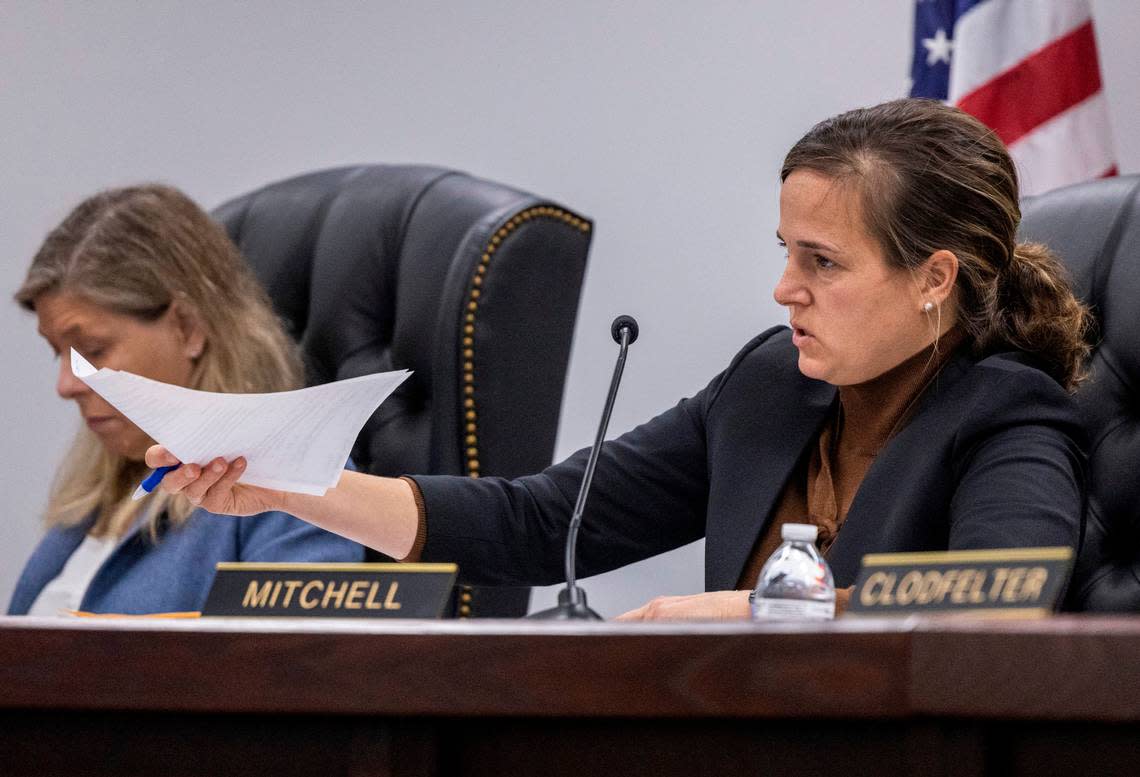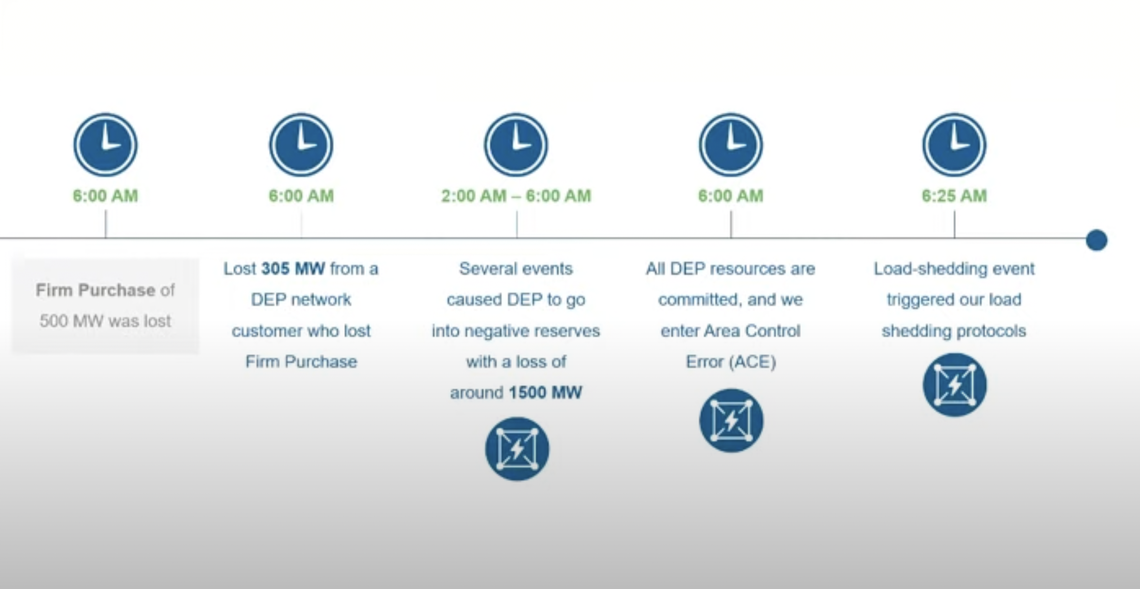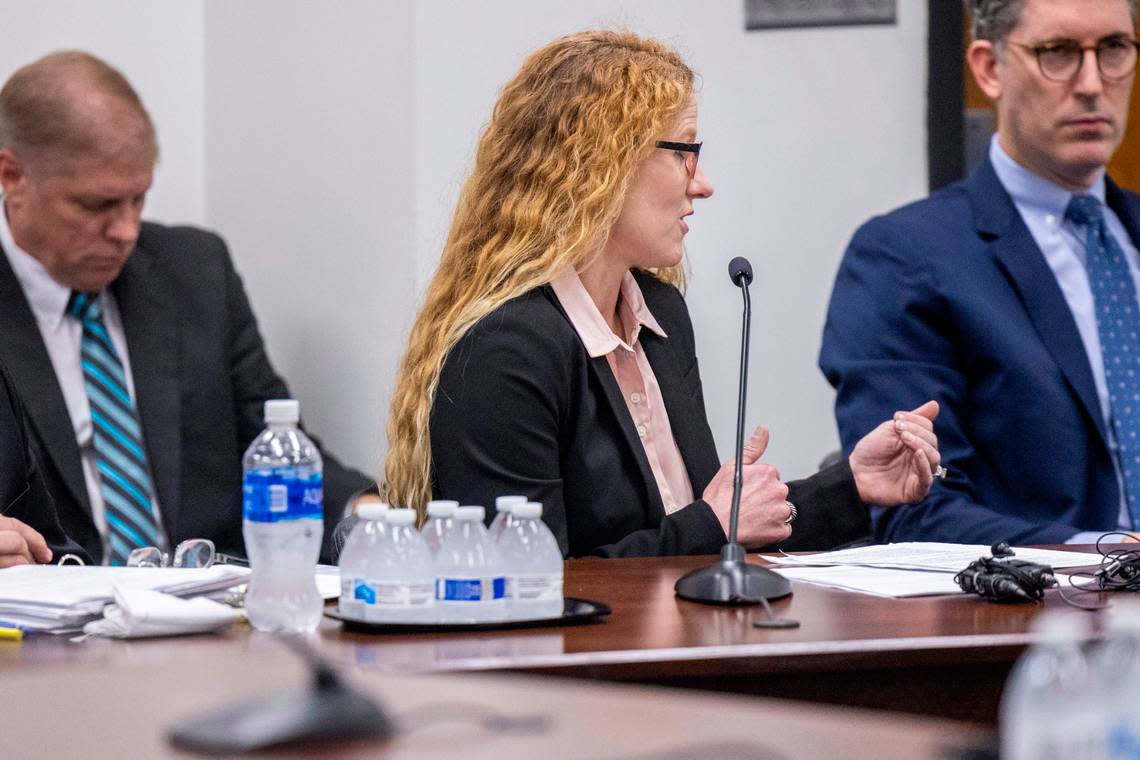‘We own what happened.’ Duke Energy details timeline of NC rolling blackouts decision
Speaking before the North Carolina Utilities Commission on Tuesday, Duke Energy leaders said the unprecedented rolling blackouts early on Christmas Eve were unfortunate but necessary as ramping-up demand was eclipsing a lower-than-expected energy supply hampered by frigid weather.
“Our operators on Christmas Eve were faced with a series of rapidly evolving events during the morning hours making rotating outages necessary to protect the integrity of the grid and mitigate the risk of serious failure affecting a far greater number of customers for longer timelines,” said Julie Janson, Carolinas CEO for Duke Energy. “We own what happened.”
Janson was among a half-dozen Duke Energy executives who walked the seven commissioners through a timeline leading up to the outages that impacted around 500,000 customers.

The first sign of trouble, executives said, occurred the night before, when energy load — the amount of power customers use — was outpacing the company’s predictive models.
Then during the pre-dawn hours of Dec. 24, Duke said multiple power plants began operating at reduced levels due to below-freezing temperatures across the state.
Emergency level rises, and neighbors can’t help

From midnight through early Christmas Eve, the company lost around 3.6% of its energy generation — a reduction of around 1,300 megawatts. As its input dropped, the company notified the North American Electric Reliability Corporation (NERC), which sets industry standards, of the mounting stress on its network.
Around 6 a.m., Duke Energy entered NERC’s most severe emergency operational level — known as Energy Emergency Alert 3 — which according to NERC’s standards is reserved for when energy load interruption “is imminent or in progress.”
In these instances, Duke typically seeks to purchase additional power from other providers, but that contingency plan fell through because these providers also faced severe weather and needed to retain their power.
“Balancing authorities did not have any available energy to move,” said Sam Holeman, the company’s vice president of construction and maintenance. “Everybody was tight. All our neighbors were tight.”
Holeman noted that during other extreme weather events, like the polar vortex of 2018, Duke had been able to purchase outside power.
A little after 6 a.m., Duke Energy’s systems had entered what is known as Area Control Error, or ACE, which means its demand-to-supply ratio is negatively affecting the broader interconnected electrical grid.
“At that time, we made the only decision that we could,” said Kendal Bowman, Duke Energy’s North Carolina state president. “For the first time in our company’s history, we began rolling service disruptions.”

The company was able to move out of Energy Emergency Alert 3 around 4 p.m. on Dec. 24 for both Duke Energy Carolinas and Duke Energy Progress customers (Carolinas and Progress are the two utilities owned by Duke Energy.) The utility fully exited NERC’s emergency level system on Dec. 26.
Power plants at reduced levels
Among the power plants hindered were two coal plants in Person County as well as a natural gas plant in Rockingham County.
“In a few cases, insulation and heat tracing did not prevent instrumentation lines from freezing, which precipitated a reduction in generation,” said Duke Energy Chief Generation Officer Preston Gillespie, who added that at no point did any plant completely stop operating.
Gillespie also said that Duke Energy’s “nuclear fleet” was reliable throughout Winter Storm Elliott and that solar power “performed as expected, but was not available to meet the demands as the peak occurred prior to sunrise.”
Last week, NERC and the Washington-based Federal Energy Regulatory Commission (FERC) announced they were opening a joint investigation into the mass outages.
Duke’s initial communication to customers indicated the outages would last between 15 and 30 minutes. Gillespie acknowledged this “information was inaccurate for some customers” as the company learned it would have to take certain manual steps to instigate the blackouts after its automatic power restoration system was impacted by a software issue.
By around noon on Dec. 24, Duke Energy had revised its restoration estimate to the end of the day.
Both officials and customers have criticized Duke Energy over its lack of notification prior to the rolling blackouts. Over Christmas weekend, Gov. Roy Cooper tweeted that he was “deeply concerned” about those who lost power without warning from the utility.
At the commission hearing Tuesday, Duke’s Janson apologized for how the communication transpired.
“We regret not being able to provide customers with as much advance notice of the outages as we would have liked and we acknowledge the outages themselves lasted far longer than we expected,” she said.
In the wake of the mass outages, Duke officials said the company has introduced a direct-to-consumer notification system to be used in the event of any future rolling blackouts.
Did the holiday mess with the model?
Since the blackouts, some have surmised that the energy crunch would have been greater had the cold temperatures not fallen on a weekend holiday when more industrial and commercial operations were closed.
That’s not the case, Duke Energy Chief Transmission Officer Nelson Peeler told commissioners, saying the divergence between the utility’s predictive model and actual customer demand would have likely been less had the weather happened on a regular weekday.
“The holiday makes it more complicated because the model is trying to determine what industrial or commercial loads are there on a Saturday Christmas Eve,” he said. “That’s a challenge to predict without history at those low temperatures.”
Peeler said the amount of consumer load, “likely from electric heating,” was not something the utility’s model had seen in the past.
Duke Energy forms its own predictive model from three industry-standard models, company officials said. In addition to miscalculating consumer demand, the weather forecast the utility used as an input into its model was one to two degrees off. While this may seem minor, Peeler said each degree of difference can represent a reduction of a few hundred megawatts of power.
Tying the outages to the Carbon Plan
The N.C. Utilities Commission is tasked with overseeing the state’s public utilities, including electric and water. Each member is appointed by the governor and confirmed by the General Assembly for six-year terms. All seven sitting members have been appointed by Cooper.
The commission is in the process of hearing Duke Energy’s requests for multiyear rate increases. It also unveiled the first version of North Carolina’s carbon reduction plan late last week, which has a goal of making the state a net zero carbon producer by 2050.
Some have argued this so-called Carbon Plan, which was mandated by House Bill 951, will precipitate more future outages. The fact that the plan calls for the closing of coal plants “means North Carolinians could face even longer and more severe rolling blackouts than what ratepayers experienced on Christmas Eve,” said Amy Cooke, CEO of the conservative John Locke Foundation, in a statement Monday.
But others contend the facts surrounding the recent outages don’t support blaming renewable energy sources.
“A crisis like the Christmas Eve blackouts often reveals the true character of different stakeholders, and it’s unfortunate that some have spread misinformation about what occurred,” said Tyler Norris, a vice president at the Durham-based solar company Cypress Creek Renewables. “Duke Energy has acknowledged that the Christmas Eve blackouts were substantially caused by failures or under-performance of their fossil generators.”
Duke execs meet with Cooper
Duke Energy executives were busy Tuesday as they also met with Cooper to discuss what transpired before and during the blackouts.
According to a statement from the governor’s office, the winter storm reduced power generation at three of Duke’s natural gas plants and a pair of its coal facilities.
“Duke officials stated that renewable energy resources performed as expected, and that the outages did not occur because of renewable energy generation,” the statement read.
At the meeting, Duke executives promised Cooper their company would address problems with its forecasting model and how it communicates with customers going forward.
“The governor acknowledged that Duke was taking responsibility for what happened and that he expects to continue to be informed about the steps Duke is taking to prevent this from ever happening again,” the statement concluded.
This story was produced with financial support from a coalition of partners led by Innovate Raleigh as part of an independent journalism fellowship program. The N&O maintains full editorial control of the work.
Open Source
Do you enjoy Triangle tech news? Subscribe to Open Source, The News & Observer's weekly technology newsletter and look for it in your inbox every Friday morning. Sign up here.
